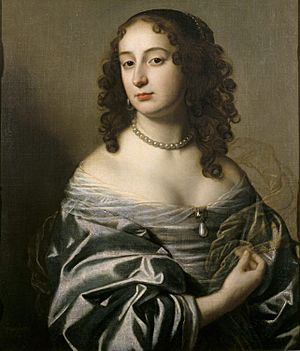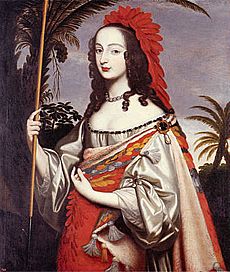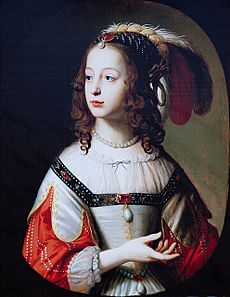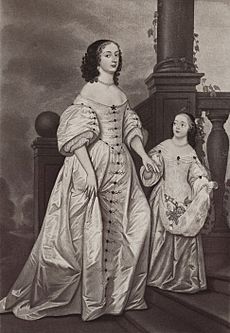Sophia of Hanover facts for kids
Quick facts for kids Sophia |
|
|---|---|
 |
|
| Electress consort of Hanover | |
| Tenure | 19 December 1692 – 23 January 1698 |
| Duchess consort of Brunswick-Lüneburg | |
| Tenure | 18 December 1679 – 23 January 1698 |
| Born | Princess Sophia of the Palatinate 14 October 1630 The Hague, Dutch Republic |
| Died | 8 June 1714 (aged 83) Herrenhausen, Hanover |
| Burial | 9 June 1714 Leine Castle, Hanover |
| Spouse |
Ernest Augustus, Elector of Hanover
(m. 1658; died 1698) |
| Issue more... |
|
| House | Palatinate-Simmern (Cadet branch of Wittelsbach) |
| Father | Frederick V, Elector Palatine |
| Mother | Elizabeth Stuart |
| Religion | Calvinism |
Sophia of Hanover (born Princess Sophia of the Palatinate; 14 October 1630 – 8 June 1714) was a very important princess. She became the Electress of Hanover when she married Elector Ernest Augustus. Later, she was the person next in line to become queen of England (which became Great Britain) and Ireland. This was because of a special law called the Act of Settlement 1701.
Sophia died when she was 83 years old. This was less than two months before she would have become queen. Because of this, her son, George I, became king instead. He took over from his cousin, Queen Anne.
Sophia was born in 1630. Her parents were Frederick V of the Palatinate and Elizabeth Stuart. Her family had to leave their home during a big war called the Thirty Years' War. They found safety in the Dutch Republic. Sophia married Ernest Augustus in 1658. Even though he was often away, Sophia loved him very much. They had seven children who grew up. Ernest Augustus became a powerful ruler, and in 1692, he was made an Elector. This meant Sophia became the Electress of Hanover, a title she is well-known for. Sophia also loved art and learning. She helped design the beautiful Herrenhausen Palace and its gardens. She also supported smart thinkers like Gottfried Leibniz.
Contents
Sophia's Early Life
Sophia was the twelfth child of Frederick V of the Palatinate and Elizabeth Stuart. Her parents were sometimes called the "Winter King and Queen of Bohemia." This was because they ruled Bohemia for only a short time. Sophia was born in The Hague, Dutch Republic. Her parents had moved there after a battle called the Battle of White Mountain.
Sophia's mother, Elizabeth Stuart, was the daughter of James VI and I. He was the King of Scotland and England. This meant Sophia was a granddaughter of a king. When she was young, her cousin, Charles II of England, tried to get her to marry him. But Sophia said no. She thought he was only interested in getting money from her mother's supporter, Lord William Craven.
Her Marriage and Family
Before she got married, Sophia was known as Princess Palatine of the Rhine. This was because her father was the Elector Palatine of the Rhine. The Electors of the Palatinate were a branch of the House of Wittelsbach family.
On September 30, 1658, Sophia married Ernest Augustus, Duke of Brunswick-Lüneburg. They got married in Heidelberg. In 1692, Ernest Augustus became the first Elector of Hanover. Ernest Augustus was also related to Sophia's mother. They were both great-grandchildren of Christian III of Denmark.
Sophia became good friends with Gottfried Leibniz. He was a famous thinker and worked as a librarian at the Hanover court. Their friendship lasted for many years, from 1676 until Sophia's death in 1714. They wrote many letters to each other. These letters show that Sophia was very smart and curious. She enjoyed reading the works of other famous thinkers like René Descartes and Baruch Spinoza.
Sophia and Ernest Augustus worked together to make Herrenhausen Palace even better. Sophia was especially important in creating the beautiful Herrenhausen Gardens around the palace. She later died in these gardens.
Sophia's Children
Sophia and Ernest Augustus had seven children who grew up to be adults. They were:
- George I of Great Britain (1660–1727)
- Frederick Augustus (1661–1690), who became an Imperial General.
- Maximilian William of Brunswick-Lüneburg (1666–1726), who became a field marshal in the Imperial Army.
- Sophia Charlotte (1668–1705), who became Queen in Prussia.
- Charles Philip of Brunswick-Lüneburg (1669–1690), a colonel in the Imperial Army.
- Christian Henry of Brunswick-Lüneburg (1671–1703).
- Ernest Augustus of Brunswick-Lüneburg, Duke of York and Albany (1674–1728), who became a prince-bishop of Osnabrück.
Sadly, three of her sons died in battles.
Sophia was away for almost a year in 1664–1665. She went on a long trip to Italy with Ernest Augustus. Even while she was away, she wrote letters to her sons' governess. She cared a lot about how her children were being raised. After her trip, she had four more sons and one daughter. In her letters, Sophia said that her oldest son, George, was very responsible. She felt he was a good example for his younger brothers and sisters.
At first, Sophia was not happy about her son George marrying Sophia Dorothea of Celle. She did not like Sophia Dorothea's mother, who was not from a royal family. Sophia also worried about Sophia Dorothea's legal status. But in the end, Sophia agreed to the marriage because it had many benefits for the family.
Next in Line for the Throne
In September 1700, Sophia met her cousin, King William III of England. They met at Het Loo Palace in the Netherlands. This meeting happened after King William's nephew, Prince William, Duke of Gloucester, had died. Prince William was the son of the future Queen Anne.
At this time, King William III was not well and did not want to marry again. This made Sophia's chances of becoming queen much higher. She was a Protestant, and so was her son. Sophia had also grown up in the Netherlands, close to William III. She could speak Dutch fluently with him, which was his first language.
A year after their meeting, the Parliament of England passed a very important law. It was called the Act of Settlement 1701. This law said that if Queen Anne or King William III had no children, the crowns of England and Ireland would go to "the most excellent princess Sophia." It also said the crowns would go to "the heirs of her body, being Protestant."
At this time, Scotland was a separate country. So, this law did not mean Sophia would also become Queen of Scotland. This caused some problems, which later led to Scotland and England joining together in 1706/1707.
The main reason Sophia was chosen was to stop James Francis Edward Stuart from becoming king. He was Roman Catholic. The Act of Settlement made sure that only Protestant heirs of Sophia could inherit the British throne. They also had to have never been Roman Catholic or married a Roman Catholic.
Some British politicians wanted Sophia to move to England. They thought this would make sure she could become queen right away if Anne died. They worried that Anne's Catholic half-brother was closer to London than Sophia. Sophia really wanted to move to London. But Queen Anne did not like this idea. She did not want a rival royal court in her kingdom. Anne might have worried that Sophia, who was still very active, would look better than her. Sophia herself was not sure what would happen after Anne's death. She once said, "What Parliament does one day, it undoes the next."
When the law was passed in 1701, Sophia was 70 years old. Five of her children and three of her grandchildren were also alive. Even though Sophia was much older than Anne, she was very healthy. She worked hard to make sure that she or her son would become the next ruler. Today, there are more than 5,000 descendants of Sophia. However, not all of them are in the line to the throne. A law called the Sophia Naturalization Act 1705 gave British citizenship to Sophia's non-Catholic descendants.
Death and Legacy
Sophia was much older than Queen Anne, but she was in much better health. A letter from a friend said that on June 5, 1714, Sophia felt ill after getting an angry letter from Queen Anne. Two days later, she was walking in the gardens of Herrenhausen. She ran to find shelter from a sudden rain shower, then collapsed and died. She was 83 years old, which was a very old age for that time.
Just over a month later, in August, Queen Anne died at the age of 49. If Anne had died before Sophia, Sophia would have been the oldest person to ever become the British monarch.
After Sophia's death, her oldest son, Elector George Louis of Brunswick-Lüneburg, became the next in line for the throne. Weeks later, he became King George I of Great Britain. Sophia's daughter, Sophia Charlotte of Hanover (1668–1705), married Frederick I of Prussia. The later kings and queens of Prussia and Germany came from her.
Sophia was first buried in the chapel of Leine Palace. Her husband and her son George I were also buried there later. During World War II, the palace and its chapel were destroyed. In 1957, Sophia's remains were moved. They are now in the mausoleum of King Ernest Augustus I in the Berggarten of Herrenhausen Gardens.
Images for kids
-
Mausoleum of King Ernest Augustus I in the Berggarten of Herrenhausen Gardens. Sophia's remains were moved here in 1957 from her first burial place.
See also
 In Spanish: Sofía del Palatinado para niños
In Spanish: Sofía del Palatinado para niños







